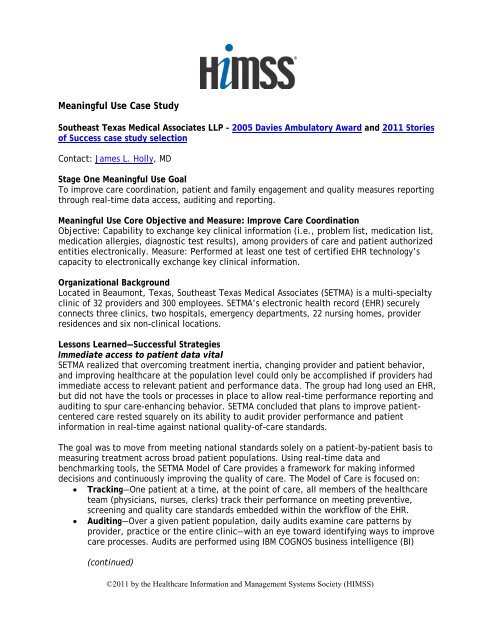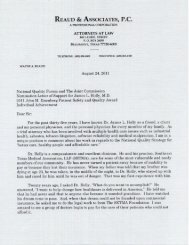Meaningful Use Case Study - himss
Meaningful Use Case Study - himss
Meaningful Use Case Study - himss
You also want an ePaper? Increase the reach of your titles
YUMPU automatically turns print PDFs into web optimized ePapers that Google loves.
<strong>Meaningful</strong> <strong>Use</strong> <strong>Case</strong> <strong>Study</strong>Southeast Texas Medical Associates LLP – 2005 Davies Ambulatory Award and 2011 Storiesof Success case study selectionContact: James L. Holly, MDStage One <strong>Meaningful</strong> <strong>Use</strong> GoalTo improve care coordination, patient and family engagement and quality measures reportingthrough real-time data access, auditing and reporting.<strong>Meaningful</strong> <strong>Use</strong> Core Objective and Measure: Improve Care CoordinationObjective: Capability to exchange key clinical information (i.e., problem list, medication list,medication allergies, diagnostic test results), among providers of care and patient authorizedentities electronically. Measure: Performed at least one test of certified EHR technology’scapacity to electronically exchange key clinical information.Organizational BackgroundLocated in Beaumont, Texas, Southeast Texas Medical Associates (SETMA) is a multi-specialtyclinic of 32 providers and 300 employees. SETMA’s electronic health record (EHR) securelyconnects three clinics, two hospitals, emergency departments, 22 nursing homes, providerresidences and six non-clinical locations.Lessons Learned—Successful StrategiesImmediate access to patient data vitalSETMA realized that overcoming treatment inertia, changing provider and patient behavior,and improving healthcare at the population level could only be accomplished if providers hadimmediate access to relevant patient and performance data. The group had long used an EHR,but did not have the tools or processes in place to allow real-time performance reporting andauditing to spur care-enhancing behavior. SETMA concluded that plans to improve patientcenteredcare rested squarely on its ability to audit provider performance and patientinformation in real-time against national quality-of-care standards.The goal was to move from meeting national standards solely on a patient-by-patient basis tomeasuring treatment across broad patient populations. Using real-time data andbenchmarking tools, the SETMA Model of Care provides a framework for making informeddecisions and continuously improving the quality of care. The Model of Care is focused on:• Tracking—One patient at a time, at the point of care, all members of the healthcareteam (physicians, nurses, clerks) track their performance on meeting preventive,screening and quality care standards embedded within the workflow of the EHR.• Auditing—Over a given patient population, daily audits examine care patterns byprovider, practice or the entire clinic—with an eye toward identifying ways to improvecare processes. Audits are performed using IBM COGNOS business intelligence (BI)(continued)©2011 by the Healthcare Information and Management Systems Society (HIMSS)
functionalities, which work in tandem with the EHR and practice management systemsto allow reporting, analysis, dashboarding and scorecards. COGNOS enables SETMA toidentify disparities and gaps in care, potential staff training/education needs andopportunities for care improvement.• Analyzing—SETMA analyzes performance audits to measure improvement by practice,clinic or provider—and to understand the meaning behind its processes and outcomesmeasures. Analysis focuses on any care discriminators—such as ethnic, age, gender,payer or treatment frequency disparities—to identify opportunities for careimprovement.• Reporting—SETMA publicly reports hundreds of quality measures on its Web site perprovider. The goal is to motivate improved performance by providers and increasedconfidence among patients, who are provided with documented plans of care to helpempower their own healthcare involvement. Reporting functions all are designed toovercome both provider and patient “treatment inertia.”• Improving—SETMA uses analysis tools to identify appropriate quality initiatives topursue. One current initiative, for instance, involves the elimination of all ethnicdiversities of care for diabetes, hypertension and dyslipidemia.ResultsSETMA meets national quality and best practice standardsThrough its EHR and BI data management tools, SETMA has eliminated any uncertainty aboutwhether it is meeting national quality standards—and its providers no longer need to waitmonths to receive quality reports from payers. COGNOS software allows every provider toexamine performance at the point-of-service on more than 200 quality metrics, including ageappropriatescreening and preventive care needs.The discrete data capture capabilities of SETMA’s EHR are used to measure, daily, eachindividual physician’s performance against “best practice” standards. Before a patient isseen, for example, his or her chart is searched to determine if standards have been met.Nurses independently initiate the completion of preventive and screening services accordingto age requirements.Dashboards enable interventions in response to seasonal patterns and population trendsSoftware also allowed SETMA to create dashboards that display seasonal outcomes patterns.For instance, trending showed diabetes patients were less healthy from October to Januarybecause of lax diet, exercise and medication interventions during the holiday season. Furtheranalysis revealed lower visit and testing frequency as well. As a result, the practice designeda plan to encourage checkups during the holidays. This issue never could have been noticed,or addressed, by looking at individual patient data.Dashboards allow the identification of population-wide trends that drive changes in practicepolicies that improve care. SETMA has been able to analyze patient populations by provider,practice, payer, ethnic group and socio-economic group. Some of the metrics reviewedinclude visit and test frequencies, number of medications taken, changes in treatments andpatient education levels.Disease management drives better high qualityIncorporating comprehensive disease management tools within EHR workflow also hasfurthered the ability of SETMA providers to deliver timely, quality care. Tools areavailable to help facilitate best practices in the diagnosis and treatment of diabetes,(continued)©2011 by the Healthcare Information and Management Systems Society (HIMSS)
hypertension, lipid abnormalities, renal disease, cardiometabolic risk and congestiveheart failure. The ability to perform quality review while in the room with a patientbolsters the provision of optimal care during every encounter. A few noteworthyoutcomes of SETMA’s data-analysis capabilities include:• Treatment compliance at 98 percent for SETMA providers on preventive services forchronic conditions like diabetes, congestive heart failure and hypertension.• Chronic disease management tools entrenched in the EHR (for chronic kidney disease,diabetes, hypertension, lipid abnormalities and more) enable the creation of highlypersonalized treatment plans. Even non-nephrology providers, for example, canquickly and accurately assess potential kidney disease.• Activity reports provided the day before a patient visit detail what each patient needsduring the next day’s visit—including requirements to meet all quality measures beingtracked.• Personalized patient education shows progress toward the accomplishment of qualitymeasures. Printers for every exam room allow providers to print personalizededucation material from the EHR, within workflow, without needing to leave the examroom.Next StepsSETMA plans to focus on improving operational results by analyzing outcomes with financialmetrics. As a private practice, it must fund everything strictly on the income it generates.The group increasingly plans to use BI to find ways to decrease costs while maintaining orimproving care quality. SETMA hopes this analysis will allow its providers to treat morepatients with the same revenue stream.###©2011 by the Healthcare Information and Management Systems Society (HIMSS)




